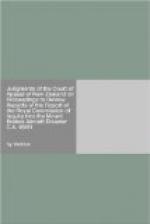The Commissioner rejected the explanations he had heard to the effect that Captain Simpson’s information seemed to point to quite a minor movement to the up-dated position of the TACAN. He stated that there appeared to have been clear advice by Captain Simpson that the “false” waypoint was 27 miles west of it. In addition he rejected the possible explanation that the advice had been misinterpreted by Captain Johnson to whom it had been given, and he adopted instead what in paragraph 245 he described as “the second explanation”:
“(b) The second explanation is that both Captain Johnston and the Navigation Section knew quite well that the McMurdo waypoint lay 27 miles to the west of the TACAN and that since his track had not officially been approved by the Civil Aviation Division it should therefore be realigned with the TACAN and then someone forgot to ensure that Captain Collins was told of the change. Such an interpretation means that the evidence as to the alleged belief of a displacement of only 2.1 miles is untrue.”
Then in paragraph 255 (d) he said this:
“If, as I have held, the Navigation Section knew the actual position of the McMurdo waypoint as being 27 miles to the west of the TACAN, then why did they not submit to Captain Johnson, or to flight Operations Division, that the waypoint should remain where it was? One view is that the Flight Operations Division expected, in terms of Captain Johnson’s letter to the Director of Civil Aviation dated 17 October 1979, that the next edition of the Ross Sea chart NZ-RNC4 would contain the official Air New Zealand flight path to McMurdo, and that the safest course would be to put the destination point back to the approximate location at which Civil Aviation Division had thought it had always been.”
That last suggestion was not put to any of the navigation witnesses at the Inquiry. It implies that although those in the navigation section believed the airline had been using a computer track to the west of Ross Island for the past year because it was the better route they nevertheless suddenly became uneasy lest knowledge of the matter would now reach the Civil Aviation Division which had not given its official blessing to the change. The idea apparently is that because the airline might receive an official rebuke the officers in the section made their own independent decision that the route must once again be directed back over Mt. Erebus.
There was no evidence at all before the Royal Commission that the approval of the Civil Aviation Division was needed for a change from the direct Cape Hallett/McMurdo route. An affidavit in support of the present application for review indicates that if the matter had been raised at the Inquiry members of the navigation section would have wished to present evidence from the Civil Aviation Division that “a change of route from the direct route to the McMurdo Sound route




